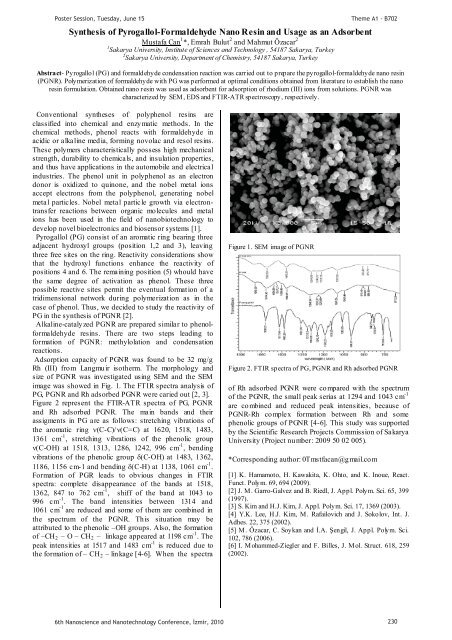Photonic crystals in biology
Photonic crystals in biology
Photonic crystals in biology
You also want an ePaper? Increase the reach of your titles
YUMPU automatically turns print PDFs into web optimized ePapers that Google loves.
Poster Session, Tuesday, June 15<br />
Synthesis of Pyrogallol-Formaldehyde Nano Res<strong>in</strong> and Usage as an Adsorbent<br />
Mustafa Can 1 *, Emrah Bulut 2 and Mahmut Özacar 2<br />
1 Sakarya University, Institute of Sciences and Technology , 54187 Sakarya, Turkey<br />
2 Sakarya University, Department of Chemistry, 54187 Sakarya, Turkey<br />
Theme A1 - B702<br />
Abstract- Pyrogallol (PG) and formaldehyde condensation reaction was carried out to prepare the pyrogallol-formaldehyde nano res<strong>in</strong><br />
(PGNR). Polymerization of formaldehyde with PG was performed at optimal conditions obta<strong>in</strong>ed from literature to establish the nano<br />
res<strong>in</strong> formulation. Obta<strong>in</strong>ed nano res<strong>in</strong> was used as adsorbent for adsorption of rhodium (III) ions from solutions. PGNR was<br />
characterized by SEM, EDS and FTIR-ATR spectroscopy, respectively.<br />
Conventional syntheses of polyphenol res<strong>in</strong>s are<br />
classified <strong>in</strong>to chemical and enzymatic methods. In the<br />
chemical methods, phenol reacts with formaldehyde <strong>in</strong><br />
acidic or alkal<strong>in</strong>e media, form<strong>in</strong>g novolac and resol res<strong>in</strong>s.<br />
These polymers characteristically possess high mechanical<br />
strength, durability to chemicals, and <strong>in</strong>sulation properties,<br />
and thus have applications <strong>in</strong> the automobile and electrical<br />
<strong>in</strong>dustries. The phenol unit <strong>in</strong> polyphenol as an electron<br />
donor is oxidized to qu<strong>in</strong>one, and the nobel metal ions<br />
accept electrons from the polyphenol, generat<strong>in</strong>g nobel<br />
metal particles. Nobel metal particle growth via electrontransfer<br />
reactions between organic molecules and metal<br />
ions has been used <strong>in</strong> the field of nanobiotechnology to<br />
develop novel bioelectronics and biosensor systems [1].<br />
Pyrogallol (PG) consist of an aromatic r<strong>in</strong>g bear<strong>in</strong>g three<br />
adjacent hydroxyl groups (position 1,2 and 3), leav<strong>in</strong>g<br />
three free sites on the r<strong>in</strong>g. Reactivity considerations show<br />
that the hydroxyl functions enhance the reactivity of<br />
positions 4 and 6. The rema<strong>in</strong><strong>in</strong>g position (5) whould have<br />
the same degree of activation as phenol. These three<br />
possible reactive sites permit the eventual formation of a<br />
tridimensional network dur<strong>in</strong>g polymerization as <strong>in</strong> the<br />
case of phenol. Thus, we decided to study the reactivity of<br />
PG <strong>in</strong> the synthesis of PGNR [2].<br />
Alkal<strong>in</strong>e-catalyzed PGNR are prepared similar to phenolformaldehyde<br />
res<strong>in</strong>s. There are two steps lead<strong>in</strong>g to<br />
formation of PGNR: methylolation and condensation<br />
reactions.<br />
Adsorption capacity of PGNR was found to be 32 mg/g<br />
Rh (III) from Langmuir isotherm. The morphology and<br />
size of PGNR was <strong>in</strong>vestigated us<strong>in</strong>g SEM and the SEM<br />
image was showed <strong>in</strong> Fig. 1. The FTIR spectra analysis of<br />
PG, PGNR and Rh adsorbed PGNR were caried out [2, 3].<br />
Figure 2 represent the FTIR-ATR spectra of PG, PGNR<br />
and Rh adsorbed PGNR. The ma<strong>in</strong> bands and their<br />
assigments <strong>in</strong> PG are as follows: stretch<strong>in</strong>g vibrations of<br />
the aromatic r<strong>in</strong>g (C-C)/(C=C) at 1620, 1518, 1483,<br />
1361 cm -1 , stretch<strong>in</strong>g vibrations of the phenolic group<br />
(C-OH) at 1518, 1313, 1286, 1242, 996 cm -1 , bend<strong>in</strong>g<br />
vibrations of the phenolic group (C-OH) at 1483, 1362,<br />
1186, 1156 cm-1 and bend<strong>in</strong>g (C-H) at 1138, 1061 cm -1 .<br />
Formation of PGR leads to obvious changes <strong>in</strong> FTIR<br />
spectra: complete disappearance of the bands at 1518,<br />
1362, 847 to 762 cm -1 , shiff of the band at 1043 to<br />
996 cm -1 . The band <strong>in</strong>tensities between 1314 and<br />
1061 cm -1 are reduced and some of them are comb<strong>in</strong>ed <strong>in</strong><br />
the spectrum of the PGNR. This situation may be<br />
attributed to the phenolic –OH groups. Also, the formation<br />
of –CH 2 – O – CH 2 – l<strong>in</strong>kage appeared at 1198 cm -1 . The<br />
peak <strong>in</strong>tensities at 1517 and 1483 cm -1 is reduced due to<br />
the formation of – CH 2 – l<strong>in</strong>kage [4-6]. When the spectra<br />
Figure 1. SEM image of PGNR<br />
Figure 2. FTIR spectra of PG, PGNR and Rh adsorbed PGNR<br />
of Rh adsorbed PGNR were compared with the spectrum<br />
of the PGNR, the small peak serias at 1294 and 1043 cm -1<br />
are comb<strong>in</strong>ed and reduced peak <strong>in</strong>tensities, because of<br />
PGNR-Rh complex formation between Rh and some<br />
phenolic groups of PGNR [4-6]. This study was supported<br />
by the Scientific Research Projects Commission of Sakarya<br />
University (Project number: 2009 50 02 005).<br />
*Correspond<strong>in</strong>g author: 0Tmstfacan@gmail.com<br />
[1] K. Hamamoto, H. Kawakita, K. Ohto, and K. Inoue, React.<br />
Funct. Polym. 69, 694 (2009).<br />
[2] J. M. Garro-Galvez and B. Riedl, J. Appl. Polym. Sci. 65, 399<br />
(1997).<br />
[3] S. Kim and H.J. Kim, J. Appl. Polym. Sci. 17, 1369 (2003).<br />
[4] Y.K. Lee, H.J. Kim, M. Rafailovich and J. Sokolov, Int. J.<br />
Adhes. 22, 375 (2002).<br />
[5] M. Özacar, C. Soykan <br />
102, 786 (2006).<br />
[6] I. Mohammed-Ziegler and F. Billes, J. Mol. Struct. 618, 259<br />
(2002).<br />
6th Nanoscience and Nanotechnology Conference, zmir, 2010 230













